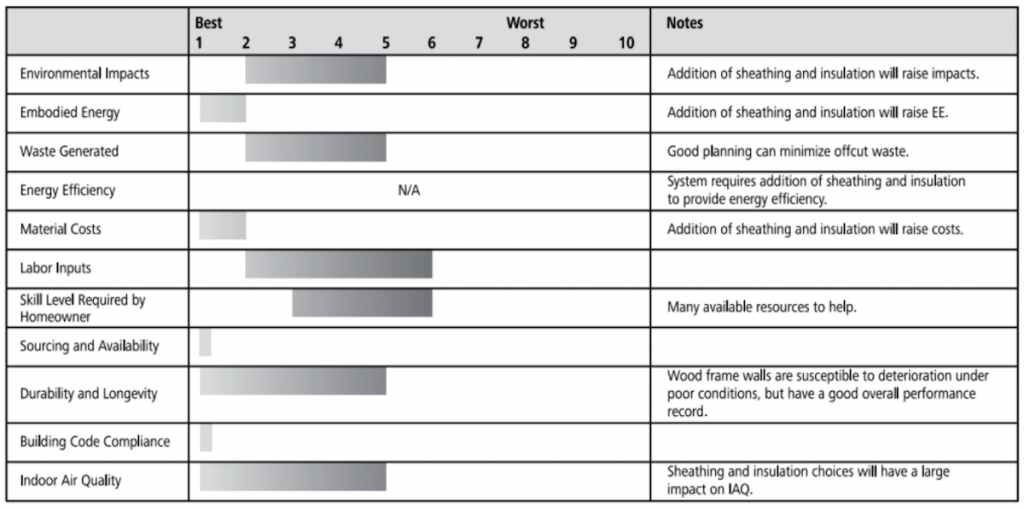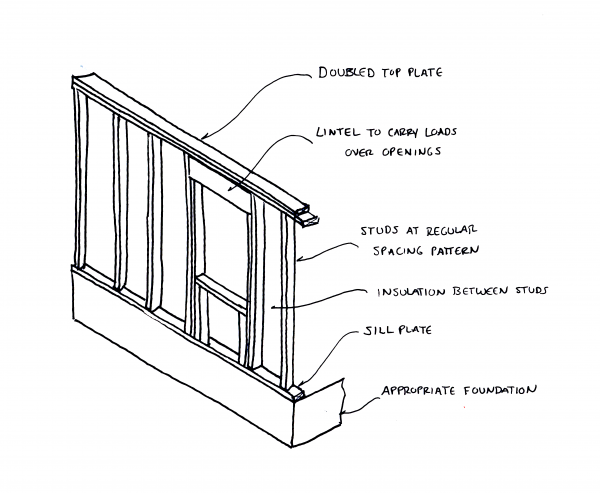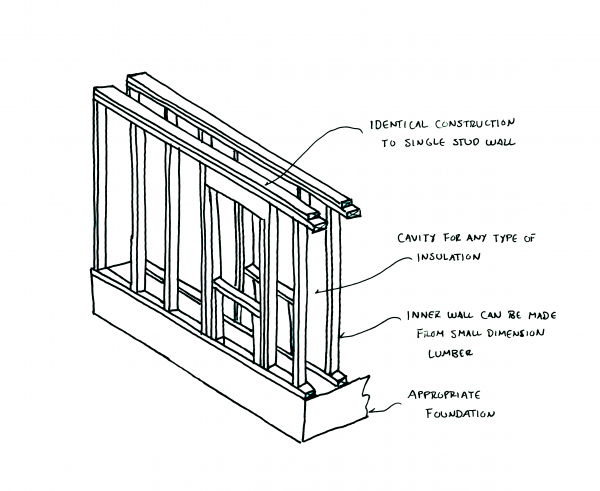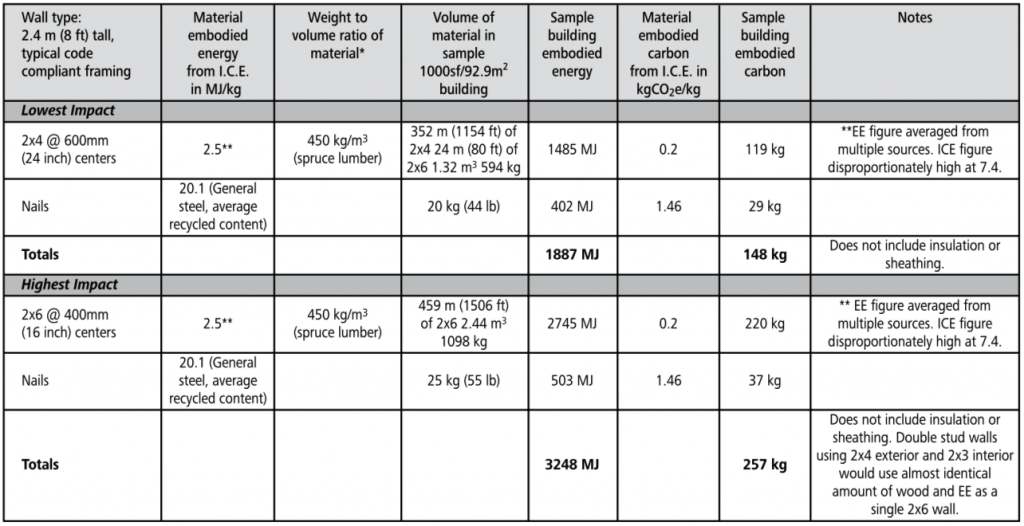Wood frame Construction
Walls: MATERIALS ENCYcLOPEDIA
Applications for this system
Exterior walls
Interior walls
Basic materials
Dimensional lumber (2×4, 2×6) studs, sills, top plates and lintels
Structural sheathing or bracing
Control layers:
Water Control — Vertical or horizontal cladding (wood, engineered wood, steel), stucco/plaster, brick and stone
Air Control — Sealed structural sheathing, house wraps, plaster
Vapor Control — Sheet barriers, sealed sheathing (gasketed drywall) and plaster
Thermal Control — Natural infill insulations (straw bale, straw/clay, hempcrete, woodchip/clay), manufactured batt insulations (cotton, hemp, wool, mineral wool, fiberglass), wet-blown cellulose, Air Krete
Ratings Chart for Wood Frame Construction

The ratings chart shows comparative performance in each criteria category. Click on the tabs below for detailed analysis of each criteria.
- HOW THE SYSTEM WORKS
- ENVIRONMENTAL IMPACTS
- WASTE
- EMBODIED CARBON
- ENERGY EFFICIENCY
- MATERIAL COSTS
- LABOUR INPUT
- SKILL LEVEL REQUIRED
- SOURCING & AVAILABILITY
- DURABILITY
- CODE COMPLIANCE
- INDOOR AIR QUALITY
- RESOURCES
- FUTURE DEVELOPMENT
wood frame construction System

 Wood frame construction uses a system of regularly spaced wooden posts or “studs” supported by a horizontal sill plate and topped with a single or double horizontal top plate to create a lightweight wall frame. There are many variations to the basic framing system: studs are typically placed at 16-inch or 24-inch centers and made from 2×4 or 2×6. Openings in the wall are built using lintel beams to transfer loads to a pair of doubled studs on either side of the opening. [drawing]
Wood frame construction uses a system of regularly spaced wooden posts or “studs” supported by a horizontal sill plate and topped with a single or double horizontal top plate to create a lightweight wall frame. There are many variations to the basic framing system: studs are typically placed at 16-inch or 24-inch centers and made from 2×4 or 2×6. Openings in the wall are built using lintel beams to transfer loads to a pair of doubled studs on either side of the opening. [drawing]
“Advanced framing” uses similar frame layouts, but the building is designed so roof rafters or trusses and openings line up with regular 24-inch centers. In this way, doubled studs and doubled top plates can be eliminated, saving a good deal of lumber. [drawing] This technique has been well documented and promoted but not widely adopted. Detractors note that a wall built in this manner does not have much redundancy built in, which can hinder future repurposing of the building.
Double stud walls are becoming more common as the need to add extra insulation and avoid thermal bridging is recognized. In this system, two frames are built for each wall, one for the exterior side and one for the interior, with a gap separating them. While this may seem more lumber-intensive at first glance, a double stud frame with 2×4 exterior wall and 2×3 interior wall uses the same amount of wood as one 2×6 wall while offering superior thermal performance. [drawing]
Frame walls and double frame walls can be built at unconventional spacing to accommodate different insulation types, such as straw bale, inside each stud cavity.
Frame walls are typically built lying down on the floor deck/foundation and raised in place, relying on temporary bracing until all walls are erected and fastened. The frames are not stable until permanent sheathing or bracing is in place.
Environmental Impact Rating
Harvesting — Negligible to High
Wood harvested from the building site or the local region can have negligible impacts. Unmanaged forestry can have impacts that include significant habitat destruction, soil erosion and ground water contamination. Third-party certification can help to ensure that impacts are minimized.
Metal fasteners may seem like a small component, but dozens of kilograms can go into a frame wall. Ore for steel production is mined in an intensive process with impacts including habitat destruction and soil and water contamination.
Manufacturing — Negligible to Moderate
The sawing and planing of structural lumber is a relatively low-impact mechanical process.
Processing raw ore into nails and screws is a multi-stage and intensive process requiring multiple infusions of high heat and fossil fuel use with impacts including air and water pollution.
Transportation — Negligible to High
Sample building uses 594 – 1,098 kg of lumber:
0.9 – 1.65 MJ per km by 15 ton truck
0.56 – 1.03 MJ per km by 35 ton truck
Timber is a heavy and high-volume material and accrues significant impacts proportional to distance traveled. In most regions it is possible to source lumber a reasonable distance from the building site.
Installation — Negligible to Moderate
The number of offcuts from a wood frame wall can be quite high. Careful cut lists and ordering can minimize this waste.
Waste: low to moderate
Biodegradable/Compostable — Wood offcuts.
Recyclable — Metal fasteners.
Landfill — Wood offcuts with impregnated fasteners, lumber tarps.
Chart of Embodied energy & carbon
Energy Efficiency: n/a
Frame walls can have widely varying levels of energy efficiency, depending on the control layers and stud layouts used. In the worst-case scenario, a thin single frame wall with plenty of thermal bridges and minimal insulation is poorly built and leaky, resulting in very poor thermal performance. In the best-case scenario a double stud wall (or single wall with adequate thermal control to prevent bridging) with excellent insulation is built airtight and offers remarkable thermal performance. Whole assembly R-values could range from as low as 9 to as high as 40 or more.
Almost any thermal control material can be used in a frame wall, which is one of the key strengths of this option. Many insulation products are designed specifically to fit into stud walls at a variety of spacings and most natural insulations are easily adapted to the frame. The specific ratings of each of these materials will have implications for overall energy efficiency and must inform the design to ensure adequate thickness and detailing. Each insulation material will have specific installation requirements that will have implications for energy efficiency. Key considerations for all insulations are tightness of fit around the frame and prevention of settling at the top of the wall, as these will lessen the insulative value and create air pockets where convection loops can create thermal short circuits.
Material costs: Low
Used in relatively small quantities, framing lumber is a low cost component of a wall system. The cost of sheathing and insulating a frame wall must be considered in addition to the basic costs of framing.
Labour Input: Moderate
The construction of wood frame walls is quite fast and relatively simple. Double frame walls will double the labor time. The majority of the labor for a frame wall system will go into the installation of the control layers and not the framing itself.
Skill level required for homeowners: moderate
Basic framing can be done by most first-time builders with adequate framing drawings and elementary carpentry skills. Training is widely available for beginning framers. Skill levels will vary for the rest of the control layers; consider the skills required to complete the entire system and not just the carpentry element.
Sourcing & availability: Easy
Framing lumber is widely available. Third-party certified lumber is beginning to find more market share, but the staff at many lumber stores do not seem to be understand the certification programs well and obtaining certified lumber may require some effort on the builder’s behalf.
Locally milled lumber will require some research to obtain, and orders may need to be placed well in advance at smaller mills. Where codes require all framing lumber to be graded, a grader may need to be hired to approve lumber from smaller mills.
Durability: High to Very High
Framing lumber is widely available. Third-party certified lumber is beginning to find more market share, but the staff at many lumber stores do not seem to be understand the certification programs well and obtaining certified lumber may require some effort on the builder’s behalf.
Locally milled lumber will require some research to obtain, and orders may need to be placed well in advance at smaller mills. Where codes require all framing lumber to be graded, a grader may need to be hired to approve lumber from smaller mills.
Code compliance
All North American building codes accept wood frame wall construction, and most prescriptive standards are based around this system. If you are building with typical stud spacings and lumber sizes and using commercial insulation products there should be no problem with approvals. The use of framing on unconventional centers may raise concerns with some building departments. Unconventional frames may need the approval of a structural engineer. However, documentation for wood frame walls makes this type of engineering relatively simple.
Some control layer strategies might require alternative compliance pathways, as they are unlikely to be formally recognized in codes. Natural insulations and plasters will probably receive the most resistance; however, if the structure meets prescribed standards many code officials are less hesitant about alternative insulations.
If the frame wall strategy uses a combination of wood frame and structural insulations/plasters, the whole system may require structural engineering.
Indoor air quality: n/a
The control layers and finishes will determine the impact of the wall system on IAQ. Frame wall systems with permeable control layers are less likely to have moisture problems than non-permeable. However, as long as adequate mechanical ventilation/dehumidification is used, a home with non-permeable walls should not experience problematic moisture levels.
Wood sawdust and most insulation materials create a lot of particulate during construction, and the home must be thoroughly cleaned to remove dust and debris prior to occupation or these dusts can be problematic in the finished home.
Natural insulations, plasters and paints will tend to have the lowest impact on IAQ, and manufactured materials and petrochemical paints the highest. The fewer chemical compounds in the materials and finishes, the less IAQ issues there are likely to be.
Resources for further research
Burrows, John. Canadian Wood-Frame House Construction. Ottawa, ON: Canada Mortgage and Housing Corporation, 2006. Print.
Thallon, Rob. Graphic Guide to Frame Construction: Details for Builders and Designers. Newtown, CT: Taunton, 2000. Print.
Newman, Morton. Design and Construction of Wood-Framed Buildings. New York: McGraw-Hill, 1995. Print.
Simpson, Scot. Complete Book of Framing: An Illustrated Guide for Residential Construction. Kingston, MA: RSMeans, 2007. Print.
Tollefson, Chris, Fred P. Gale, and David Haley. Setting the Standard: Certification, Governance, and the Forest Stewardship Council. Vancouver, BC: UBC Press, 2008. Print.
Wood certification programs:
fsc.org/ and fsccanada.org/
Future development
Frame wall systems have had the benefit of decades of study, refinement and codification. Structurally, there is little to improve upon in the future. The increased acceptance and availability of certified wood will have a positive effect on frame construction in the upcoming years.
The understanding of control layers and how to best select and install appropriate layers will be the most important development in frame wall construction. In particular, the acceptance of permeable wall systems will make the use of low-impact natural materials more widely acceptable.
Frame wall construction is unlikely to be replaced as the most widely used building system for residential construction. Refinements to improve performance and environmental responsibility are being actively pursued by the industry and will be gradually accepted in codes.
Tips for successful wood frame construction
1. There are many excellent guides to wood frame construction. Consult these resources in the planning stage to optimize frame design and layout.
2. Ensure that wall frames are built to best suit the sheathing and insulation intended for use. For manufactured sheet materials (OSB, plywood, drywall), proper stud layout and wall heights will result in efficient use and minimal cutting of these materials. For alternative insulations, be sure to create layouts that similarly optimize efficiency.
3. Both the designer and builder need to thoroughly understand all four control layers and how they will intersect at corners, openings and junctions with roof and foundation.
4. Use properly sized, galvanized fasteners in the recommended patterns.
5. Create complete framing drawings so that the arrangement of studs is clear and easy to follow. This can allow for efficient ordering and use of materials on-site.




